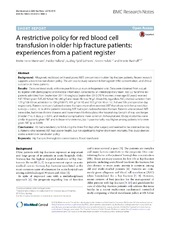A restrictive policy for red blood cell transfusion in older hip fracture patients: experiences from a patient register
Peer reviewed, Journal article
Published version

Åpne
Permanent lenke
https://hdl.handle.net/1956/15759Utgivelsesdato
2016-02-09Metadata
Vis full innførselSamlinger
Originalversjon
https://doi.org/10.1186/s13104-016-1885-xSammendrag
Background: Allogeneic red blood cell transfusions (ABT) are common in older hip fracture patients. Recent research supports a restrictive transfusion policy. The aim was to study variation in hemoglobin (Hb) concentration, and clinical outcomes in these patients. Results: Cross-sectional study with one-year follow-up in an orthogeriatric unit. Data were obtained from a quality register with demographic and medical information collected by an interdisciplinary team. 106 (22 %) of the 491 patients admitted from September 2011 throughout September 2012 (76 % women, mean age 85 years) received ABT. When given ABT, 80 % had Hb <80 g/l and mean Hb was 78 g/l. Mean Hb, regardless ABT, showed variation from 125 g/l (±16) on admission to 106 g/l (±17), 101 g/l (±16) and 102 g/l (±14) on 1st, 3rd and 5th postoperative day respectively. Patients with per-/subtrochanteric fractures more often received ABT than those with femur neck fractures (p < 0.001), 70 % of the patients receiving ABT had a per-/subtrochanteric fracture. Patients who received ABT were older, had more chronic diseases and lower mean Hb throughout the hospital stay. Length of stay was longer (median 7 vs. 6 days, p = 0.01), and medical complications more common. In-hospital and 30-day mortalities were similar in patients given ABT and in those who were not, but 1-year mortality was higher among patients who were given ABT (p = 0.008). Conclusions: Hb had a tendency to fall during the three first days after surgery and seemed to be stabilized on day 5. Patients who received ABT had poorer health, but not significantly higher short-term mortality. This study demonstrates a restrictive transfusion policy
